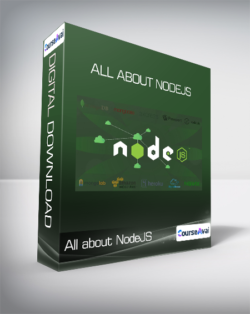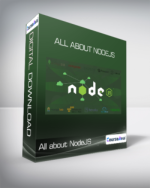NodeJS is a platform that allows developers to write server side high performance and networked applications. And that too using good old Javascript. File size: 2.78 GBPurchase All about NodeJS courses at here with PRICE $49 $18All about NodeJSWhat you’ll learnBuild High Performance and Scalable Apps using NodeJSLearn about ES6 with my free eBook – ECMAScript 6 QuickBytesUse NodeJS Streams to write a Web ServerUse the Node Package Manager (NPM) for managing dependenciesUse the Express 4 Framework for building NodeJS AppsUse the EJS templating languageUnderstand MongoDB as a NoSQL DatabaseCreate & Use MongoDB Databases using services like MongoLabCreate Realtime Apps that use Web SocketsUpload & Resize Images using NodeJSIntegrate Authentication using Social Media Sites like FacebookStructure the NodeJS app into modulesCreate and Deploy EC2 Cloud Server Instances on Amazon Web ServicesCreate and Use Amazon’s S3 Storage Service with NodeJSUse Amazon’s Cloudfront ServiceUsing Amazon’s Elastic IPConfigure Security Groups, Ports & Forwarding on Amazon EC2Deploy a NodeJS app on the EC2 InstanceDeploy a NodeJS app on HerokuDeploy a NodeJS app on Digital OceanInstall & Deploy NGINX as a Reverse Proxy Server for NodeJS AppsConfigure NGINX as a Load BalancerLearn about Enterprise IntegrationCreate an app using the incredible Hapi frameworkLearn more about logging using the Hapi frameworkLearn to use ES6 with NodejsInstall & Deploy Apache Apollo MQ with Nodejs and a Python ScriptCourse contentExpand all 136 lectures15:52:02-Prologue16:17What is NodeJS ?Preview14:19Before You Begin | ECMAScript 6 QuickBytes | Free eBook01:58-Installing NodeJS11:44Installing NodeJS on Windows01:55Installing NodeJS on a MacPreview01:42Installing NodeJS on Linux (Ubuntu)02:51Installing and using muliple versions of NodeJS (Only on Mac/Linux)05:16-NodeJS Fundamentals02:24:54Before You Begin : Important Note01:12Read-Evaluate-Print-Line | REPL & Hello Node !Preview03:23Hello NodeJS11:57Hello Routing! | Understanding how Requests & Responses work08:06Hello Routing! | Handling GET Requests17:44Hello Routing! | Handling POST Requests11:30NodeJS at its core02:51Build a Web Server | Basic20:43Promise me you’ll never callback14:15Build a Web Server | Using Streams06:50Modules & NPM19:25Writing your own Module!17:25Enigma v209:33-MongoDB 10131:06Introduction to MongoDB09:55Installing MongoDB on WindowsPreview09:48Installing MongoDB on a Mac04:21Playing with the MongoDB Shell07:02-NodeJS Frameworks26:38What are frameworks?08:33Express and the MEAN Stack06:49Beyond the MEAN Stack11:16-ChatCAT – Creating a Realtime Multiroom Chat App & Deploying it on Heroku06:06:39The Goal04:22Structuring the app05:37Examining the user interface03:59Installing Nodemon03:36npm init and here we go!Preview12:35Hello Express!11:17Middleware Ahoy!06:04The View Renderer12:24Serving Static Assets03:58Express Router : First Steps06:32Express Router : The routes object05:28Express Router : Mounting the routes – 110:03Express Router : Mounting the routes – 204:24Express Router : Handling a 40405:36Do we need a database? Yes we do!03:32MongoDB as a service | MongoLab.com07:13Migrating to MongoDB Atlas – IMPORTANT01:37Environments and the config loader08:26Mongoose and the database module04:12Sessions 10104:53Implementing sessions using the express-session middleware11:40Social Authentication : An Introduction05:13Social Authentication : Introduction to Passport08:50Social Authentication : Installing Passport & Strategies01:16Social Authentication : Registering the app on Facebook08:55Social Authentication : Facebook Strategy05:25Social Authentication : Database helpers10:44Social Authentication : Serializing & deserializing user data04:17Social Authentication : Routes04:48Updates to Facebook Login | Enforcing HTTPS00:27Social Authentication : Rendering name and profile picture02:05Social Authentication : Registering the app with Twitter04:22Social Authentication : Twitter Strategy02:11Social Authentication : The logout button01:57Social Authentication : Securing routes03:24Socket.io | An introduction07:22Socket.io | Installation and rewiring the server03:57Socket.io | Storing chat rooms and user data03:48Socket.io | Bridging Socket.io with Session02:25Socket.io | Setting up the Rooms Page06:26Socket.IO | Rendering the list of chatrooms07:28Socket.IO | Creating a new chatroom12:14Socket.IO | The chatroom route07:36Socket.IO | Joining a chatroom16:10Socket.IO | Updating the list of active users05:01Socket.IO | When a user leaves or disconnects05:12Socket.IO | The chat functionality09:17Sending images using Cloudinary (Optional)07:20Socket.IO | Scaling with Redis20:04Logging with Winston09:08Logging requests using Morgan03:31Heroku | An introduction06:56Heroku | Installing the Heroku Toolbelt CLI01:47Heroku | Preparing for deployment08:26Heroku | Setting up configuration variables03:45Heroku | Provisioning Redis02:40Get All about NodeJS downloadHeroku | Reconfiguring Facebook & Twitter and Deployment!04:17Heroku | Monitoring your app04:21Scaling up – An insight | Summary06:06-Node.JS on Amazon Web Services !02:44:17Introduction to Project PhotoGRID05:11IMPORTANT : Before you Begin2 pagesExamining the User Interface & Getting Started06:41Creating the Express App & Setting up Socket.io08:10Creating the Routes.js module01:46Creating Configuration Files03:02Amazon Web Services | Signing Up & Creating an S3 Bucket05:36Amazon Web Services | Setting up a Bucket Policy04:53Amazon Web Services | Setting up Knox05:04Setting up the Upload Button Handler & AJAX14:48Setting up Formidable for Receiving the files13:41Setting up GraphicsMagick Library + gm for Nodejs for resizing images05:16Uploading resized images to the S3 using Knox05:13Storing the file name and votes in MongoDB on MongoLab12:05Getting images into the Photogrid gallery15:36Amazon Web Services | Setting up CloudFront Distribution04:19Creating the Vote Up Functionality & Final Testing10:50Amazon Web Services | Creating an Elastic Compute Cloud (EC2) Instance05:58Amazon Web Services | Installing NodeJS on EC204:38Amazon Web Services | Creating an Elastic IP for your EC2 Instance03:11Amazon Web Services | Installing the Photogrid App on the EC2 Instance06:55Amazon Web Services | Security Group, Ports & Port Forwarding14:07Amazon Web Services | Ensuring the Photogrid app runs automatically07:17-NodeJS and NGINX for the Kill !37:55What are we talking about ?03:38The Awesome Cloud9 IDE07:12Spinning a Droplet on Digital Ocean & Using Cloud9IDE07:31Installing Nginx01:38Nginx as a Proxy Server for NodeJS07:55Uploading and Reconfiguring ChatCAT to work with Nginx06:02Load Balancing with NGINX03:59-Enterprise Integration | ES6 | HapiJS02:30:27Introduction to Enterprise Integration10:56The task at hand07:56Installing Python dependencies on a Mac02:41Installing Python dependencies on Windows03:02Installing Apache Apollo on a Mac06:27Installing Apache Apollo on Windows05:35Configuring Apache Apollo | Users and Queues03:42Introduction to the Hapi Framework06:08Hello Hapi and a bit of ES610:34Writing the Core Plugin | Routes & Views16:38Setting up Socket.io13:13Setting up the Stomp Client & Storing Access Credentials10:22The ‘Process’ Button State09:03Core Functionality : The Workflow04:02Core Functionality : The Code16:31UPDATE : Fixing the Array.observe() deprecation issue08:47Fixing data retrieval on a page refresh05:09Logging using Hapi07:12Summary02:29-Epilogue00:21Recommended Reading & Resources1 pageBONUS : Join my inner circle of friends!00:21RequirementsWorking knowledge of HTML, CSS and JavascriptBasic Working knowledge of an image editing application such as Adobe Photoshop would also help, but is not necessarily needed.About this CourseNodeJS is a platform that allows developers to write server side high performance and networked applications. And that too using good old Javascript. But wait ! Isn’t Javascript meant to be used for forms and stuff on web pages ?Well that was 10 years ago. The world has gone from ‘Oops! You’ve not filled up the form properly !’ days to today’s modern web apps and social media sites that rely heavily on Javascript. Google Apps, Facebook, Twitter, Google Plus and LinkedIn, being handful examples of this movement. And to think that this quantum leap would not have been possible without Javascript is not an overstatement. Today, when you socialize with your friends on Facebook, or use your Gmail inbox, you’re running thousands of lines of code written in Javascript, in your browser.With Node JS, you can take this knowledge back on the server, where usually you would expect to see the likes of PHP, Ruby, ASP dot NET etc. But that’s only a small portion of the reason why NodeJS is so cool. The fact that you can write full blown networked applications (think chat servers, collaborative tools, real-time data visualisation apps) with just a few lines of code is more than reason enough to not only look at NodeJS, but deep dive into it !But I know PHP ? Why should I learn NodeJS ? Well, for starters, learning something new never hurts. But most importantly, learning NodeJS is great because :Node allows you to write highly scalable networked apps deployed on the cloud !You’re working at a different level of application design per se with Node and that means that you’re not writing an app that sits on top of a stack, you design the stack from the server up. And while that may sound daunting, it really is not and you’ll see why.You code in the same language, both on the server and on the front end ! We’re all polyglots (we use multiple programming languages and syntax in most of our projects), but managing code in the same language on the back-end and the front-end never hurts and in-fact can be a huge time saver when debugging.NodeJS is used by the likes of LinkedIn, Yahoo and Microsoft to name a few. Its pretty new and consequently you gain advantage from the exponentially growing community of NodeJS & Javascript developers and that’s great fun, really !If you’ve been coding in Javascript, you can leverage your existing knowledge and skills and take it to a whole new level !The Real ProblemSo, NodeJS sounds pretty interesting so far, but what really hit me in the face when I was learning all about Node was the fact that, with any new platform, framework or technology, you need to take baby steps, all the way through, to making real world examples, if you have to get to the grips of it. And that leads us to why you’re here.In this course, we’ll go from absolute scratch, all the way up to building and deploying full blown NodeJS app on the Cloud !Project Oriented LearningWith NodeJS, we will build two full blown apps. We will go all the from concept creation, UI/UX design to coding and deploying our app on the cloud.A. ChatCAT – One of the fun things that you can do with NodeJS is build realtime apps that allow a high number of concurrent users to interact with each other. Examples of this kind include Chat Servers, Gaming Servers, Collaborative Tools etc. We will build a multi-room chat server that allows users to login via Facebook, Create Chatrooms of their choice and Chat in realtime. We will not only create this app, but also deploy it on Heroku and Digital Ocean !You will learn all about using Websockets, Structuring your App in an efficient manner, creating and using development & production configurations, Authentication using Facebook, Setting up an App on Facebook, Managing Sessions, Querying & Using a Hosted MongoDB Database, Using Heroku & Digital Ocean’s Cloud Services and lots more…B. PhotoGRID – The second complete app that we will build in this course is a Photo Gallery app which lets users upload images into a gallery with the ability to vote up the images that they like. This NodeJS app lets users upload files, which are then resized to thumbnails on the server and stored in an Amazon S3 Bucket for optimal delivery to the front end interface. The entire app runs on an Amazon EC2 Cloud Server which we will create from scratch and configure for use.You will learn about managing file uploads using NodeJS & AJAX, Resizing Images on the Server, Accessing & Storing files in an S3 Bucket, Querying & Using a Hosted MongoDB Database, Using Amazon’s Elastic IP Service & Cloudfront distribution, ensuring your NodeJS app runs automatically even if the server is restarted and lots more…In the projects above, we leave no stone unturned in terms of execution. This is a complete hands-on course that is not just limited to NodeJS but to the ecosystem that needs attention when a NodeJS app is built and deployed. My intent is hand hold you all the way from writing your first app to deploying production level apps on the cloud.And I’m always available to personally help you out, should you get stuck.BONUS :: Here’s the best thing about this course. The curriculum that you see gets you up and running with NodeJS & Cloud Deployment. However, there is so much more that you can do with NodeJS, which is why I will keep adding new lectures and sections to this course on an ongoing basis. There is so much more that you will get with full lifetime access to lectures and all updates !!So, join in the fun !Who this course is for:Understand the inner workings of NodeJSWeb Designers & Front End Developers who wish to extend their knowledge of Javascript for building high performance network applications.Software Developers who want to build high performance network applications.Absolute beginners with basic knowledge of HTML, CSS and Javascript, wanting to upgrade to professional Web Development and Building Web Apps.Anyone who wishes to get hands-on training with setting up an Amazon EC2 Instance with a host of other services like Cloudfront, Elastic IP and S3Anyone who wishes to get hands-on training with deploying a NodeJS app on the cloudComputer Engineering studentsTech Entrepreneurs who want to get their hands down and dirty with Web Coding & App Development.Anyone who wishes to stay on the forefront of technology !PHP, ASPnet, Perl, Java & Ruby coders wanting to leap onto the NodeJs bandwagon.Get All about NodeJS downloadPurchase All about NodeJS courses at here with PRICE $49 $18







